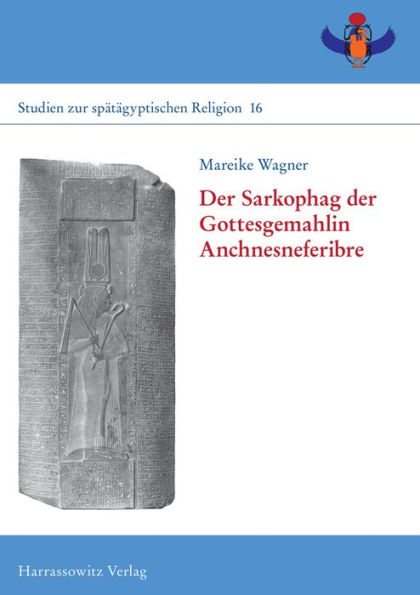5
1


Hardcover
$170.00
-
PICK UP IN STORECheck Availability at Nearby Stores
Available within 2 business hours
Related collections and offers
170.0
In Stock
Overview
English summary: The sarcophagus of the "God's Wife of Amun" Ankhnesneferibre, a daughter of Pharaoh Psamtik II, was discovered in 1832 in an previously unknown grave behind the Temple of Hathor in Deir el-Medineh on the west bank of the Nile. The sarcophagus is today held in the British Museum in London. The rectangular sarcophagus was made from black basalt and is distinguished by its perfect state of preservation and its quality craftsmanship, which by means of photographic documentation on a DVD, as well as numerous folding-panel renditions, is now made wholly visible in its pictorial form for the first time. On the interior of the sarcophagus, the initial trace-work for the later engraved hieroglyphs is still visible, indicated by their red color. In addition to three large-panel images (an image of the deceased from the lid of the sarcophagus, a rendition of the sky-goddess Nut from the underside of the lid, and a representation of the god of the west Imentet on the interior floor of the sarcophagus) the chief form of decoration for the sarcophagus comes in the form of inscriptions, which were added to the outer and inner sides of the sarcophagus in numerous columns. Most of the inscriptions are short excerpts from the well-known body of pyramid texts and the Book of the Dead, although there is also a previously unknown "new" text, which to date has only been found on this sarcophagus. On the basis of a translated version of the text, the focus rests on a contextual classification and commentary of these inscriptions, which represent a prime example for the changes in religious beliefs in the late period and presents the constructive, and creative interplay of texts in that period. German description: Amun Ankhnesneferibre, a daughter of Pharaoh Psamtik II, was discovered in 1832 in a previously unknown grave behind the Temple of Hathor in Deir el-Medineh on the west bank of the Nile. The sarcophagus is today held in the British Museum in London. The rectangular sarcophagus was made from black basalt and is distinguished by its perfect state of preservation and its quality craftsmanship, which by means of photographic documentation on a DVD as well as numerous folding-panel renditions, is now for the first time made wholly visible in its pictoral form. On the interior of the sarcophagus, the initial tracing of the later engraved hieroglyphs are still visible through their red color. In addition to three large-panel images (an image of the deceased from the lid of the sarcophagus, a rendition of the sky-goddess Nut from the underside of the lid, and a representation of the god of the west Imentet on the interior floor of the sarcophagus) the chief form of decoration for the sarcophagus comes in the form of inscriptions, which were added to the outer and inner sides of the sarcophagus in numerous columns. Most of the inscriptions are short excerpts from the well-known body of pyramid texts and the Book of the Dead, although there is also a previously unknown new text, which to date has only been found on this sarcophagus. On the basis of a translated version of the text, the focus rests on a contextual classification and commentary of these inscriptions, which represent a prime example for the changes in religious beliefs in the late period and presents the constructive, and creative interplay of texts in that period. German description:Der Sarkophag der Gottesgemahlin Anchnesneferibre, einer Tochter des Konigs Psametik II., wurde 1832 in einem eher unscheinbaren Grab hinter dem Hathor-Tempel von Deir el-Medineh auf der Westseite des thebanischen Nilufers entdeckt. Er befindet sich heute im British Museum in London. Der rechteckige Sarkophag aus Siltstein zeichnet sich durch seine perfekte Erhaltung und seine qualitatvolle Verarbeitung aus, welche mittels der fotografischen Dokumentation auf einer DVD sowie einer zeichnerischen Wiedergabe in den entsprechenden Klapptafeln nun erstmals allgemein ersichtlich gemacht werden. Auf den Innenseiten der Wanne lassen sich sogar noch die Vorzeichnungen der spater eingravierten Hieroglyphen in roter Farbe erkennen. Neben drei grossflachigen Abbildungen - einem Bildnis der Verstorbenen auf dem Deckel des Sarkophags, einer Wiedergabe der Himmelsgottin Nut auf der Unterseite des Deckels und einer Darstellung der Westgottin Imentet auf dem Boden der Wanne - besteht die Dekoration des Sarkophags hauptsachlich aus Inschriften, die um die Darstellungen und auf den Aussen- und Innenseiten der Wanne in zahlreichen Textkolumnen angebracht wurden. Dabei handelt es sich neben kleinen Auszugen aus den bekannten Corpora der Pyramidentexte und des Totenbuches hauptsachlich um unbekannte, "neue" Texte, die bislang nur auf diesem Sarkophag zu finden sind. Auf der Grundlage einer Ubersetzung liegt der Schwerpunkt auf einer inhaltlicher Einordnung und Kommentierung dieser Inschriften, die ein Paradebeispiel fur die Veranderungen der religiosen Vorstellungen der Spatzeit darstellen und den konstruktiven, bisweilen kreativen Umgang mit Textgut prasentieren.

Product Details
| ISBN-13: | 9783447105040 |
|---|---|
| Publisher: | Harrassowitz Verlag |
| Publication date: | 07/15/2016 |
| Series: | Studien zur spatagyptischen Religion , #16 |
| Pages: | 618 |
| Product dimensions: | 6.50(w) x 1.50(h) x 9.50(d) |
| Language: | German |
From the B&N Reads Blog
Page 1 of
